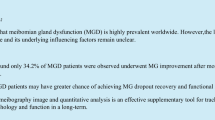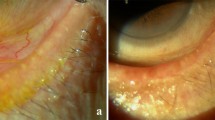Abstract
Purpose
To evaluate meibomian gland loss after trabeculectomy with mitomycin C (MMC).
Methods
This cross-sectional observational case study involved 55 eyes in 39 patients who had undergone trabeculectomy with MMC administered to the upper area of the eye. We used a mobile pen-shaped noncontact meibography system to access the morphology and determine loss of the meibomian glands. Meibomian gland loss was scored (meiboscore) from grade 0 (no loss of the meibomian glands) through grade 3 (loss of more than two-thirds of the total area) in the bleb-contacting and bleb-noncontacting upper eyelid areas in the primary position and in the lower eyelid. The tear film breakup time (BUT) was also measured.
Results
The median duration from trabeculectomy to examination was 7.4 years (interquartile range 3.1–14.2). The meiboscores of the bleb-contacting upper eyelid areas were significantly higher than those for the bleb-noncontacting upper eyelid areas (P < 0.001). The meiboscores for both the bleb-contacting and the bleb-noncontacting upper eyelid areas were significantly higher when the bleb was avascular (P = 0.011 and P = 0.008, respectively). The meiboscores of the bleb-contacting and bleb-noncontacting upper eyelid areas showed a significant negative correlation with the BUT (r = −0.330, P = 0.014 and r = −0.296, P = 0.028, respectively).
Conclusion
Blebs that occur after trabeculectomy with MMC may be the cause of meibomian gland loss, particularly when the bleb is avascular. The presence of an avascular bleb warrants extra vigilance for decreased meibomian gland secretions because this decrease can lead to tear dysfunction and ocular surface damage, including bleb-wall damage.




Similar content being viewed by others
References
Kitazawa Y, Kawase K, Matsushita H, Minobe M. Trabeculectomy with mitomycin: a comparative study with fluorouracil. Arch Ophthalmol. 1991;109:1693–8.
Belyea DA, Dan JA, Stamper RL, Lieberman MF, Spencer WH. Late onset of sequential multifocal bleb leaks after glaucoma filtration surgery with 5-fluorouracil and mitomycin C. Am J Ophthalmol. 1997;124:40–5.
Li J, Pang L. Influence on tear film of postoperative 5-fluourouracil and intraoperative mitomycin C in glaucoma filtration surgery [in Chinese]. Zhonghua Yan Ke Za Zhi. 2001;37:43–7.
Sagara H, Iida T, Suzuki K, Fujiwara T, Koizumi H, Yago K. Sodium hyaluronate eye drops prevent late-onset bleb leakage after trabeculectomy with mitomycin C. Eye. 2008;22:507–14.
Lee SY, Wong TT, Chua J, Boo C, Soh YF, Tong L. Effect of chronic anti-glaucoma medications and trabeculectomy on tear osmolarity. Eye. 2013;27:1142–50.
Ono T, Yuki K, Ozeki N, Shiba D, Tsubota K. Ocular surface complications after trabeculectomy: incidence, risk factors, time course and prognosis. Ophthalmologica. 2013;230:93–9.
Mietz H, Brunner R, Addicks K, Krieglstein GK. Histopathology of an avascular filtering bleb after trabeculectomy with mitomycin-C. J Glaucoma. 1993;2:266–70.
Sagara H, Iida T, Saito K, Noji H, Ogasawara M, Oyamada H. Conservative treatment for late-onset bleb leaks after trabeculectomy with mitomycin C in patients with ocular surface disease. Clin Ophthalmol. 2012;6:1273–9.
Katz LJ, Cantor LB, Spaeth GL. Complications of surgery in glaucoma: early and late bacterial endophthalmitis following glaucoma filtering surgery. Ophthalmology. 1985;92:959–63.
Azuara-Blanco A, Katz LJ. Dysfunctional filtering blebs. Surv Ophthalmol. 1998;43:93–126.
Mishima S. Some physiological aspects of the precorneal tear film. Arch Ophthalmol. 1965;73:233–41.
Bron AJ, Tiffany JM, Gouveia SM, Yokoi N, Voon LW. Functional aspects of the tear film lipid layer. Exp Eye Res. 2004;78:347–60.
Begley CG, Chalmers RL, Mitchell GL, Nichols KK, Caffery B, Simpson T, et al. Characterization of ocular surface symptoms from optometric practices in North America. Cornea. 2001;20:610–8.
Pisella PJ, Malet F, Lejeune S, Brignole F, Debbasch C, Bara J, et al. Ocular surface changes induced by contact lens wear. Cornea. 2001;20:820–5.
Arita R, Itoh K, Inoue K, Kuchiba A, Yamaguchi T, Amano S. Contact lens wear is associated with decrease of meibomian glands. Ophthalmology. 2009;116:379–84.
Arita R, Itoh K, Maeda S, Maeda K, Tomidokoro A, Amano S. Association of contact lens-related allergic conjunctivitis with changes in the morphology of meibomian glands. Jpn J Ophthalmol. 2012;56:14–9.
Arita R, Itoh K, Maeda S, Maeda K, Furuta A, Fukuoka S, et al. Proposed diagnostic criteria for obstructive meibomian gland dysfunction. Ophthalmology. 2009;116:2058–63.
Mathers WD, Billborough M. Meibomian gland function and giant papillary conjunctivitis. Am J Ophthalmol. 1992;114:188–92.
Sotozono C, Ang L, Koizumi N, Higashihara H, Ueta M, Inatomi T, et al. New grading system for the evaluation of chronic ocular manifestations in patients with Stevens–Johnson syndrome. Ophthalmology. 2007;114:1294–302.
Ogawa Y, Okamoto S, Wakui M, Watanabe R, Yamada M, Yoshino M, et al. Dry eye after haematopoietic stem cell transplantation. Br J Ophthalmol. 1999;83:1125–30.
Pisella PJ, Pouliquen P, Baudouin C. Prevalence of ocular symptoms and signs with preserved and preservative free glaucoma medication. Br J Ophthalmol. 2002;86:418–23.
Arita R, Itoh K, Maeda S, Maeda K, Furuta A, Tomidokoro A, et al. Comparison of the long-term effects of various topical antiglaucoma medications on meibomian glands. Cornea. 2012;31:1229–34.
Clarke J. Moorfields Bleb Grading System. Moorfields Bleb Grading System Web site. Available at: www.blebs.net/html/Protocol.html. Accessed December 14, 2013.
Park HY, Ahn MD. Imaging of trabeculectomy blebs with Visante anterior segment optical coherence tomography after digital ocular compression. Jpn J Ophthalmol. 2012;56:38–45.
Kiuchi T, Okamoto H, Ishii K, Oshika T. Amniotic membrane transplantation for late-onset bleb leakage with scleritis. Jpn J Ophthalmol. 2005;49:56–8.
Arita R, Itoh K, Maeda S, Maeda K, Amano S. A newly developed noninvasive and mobile pen-shaped meibography system. Cornea. 2013;32:242–7.
Norn MS. Diagnosis of dry eye. In: Lemp MA, Marquardt R, editors. The dry eye: a comprehensive guide. Berlin: Springer; 1992. p. 133–82.
Methodologies to diagnose and monitor dry eye disease. report of the Diagnostic Methodology Subcommittee of the International Dry Eye WorkShop (2007). Ocul Surf. 2007;5:108–52.
Bron AJ, Evans VE, Smith JA. Grading of corneal and conjunctival staining in the context of other dry eye tests. Cornea. 2003;22:640–50.
Neves Mendes CR. Hida RY, Kasahara N. Ocular surface changes in eyes with glaucoma filtering blebs. Curr Eye Res. 2012;37:309–11.
Shields JA, Demirci H, Marr BP, Eagle RC Jr, Shields CL. Sebaceous carcinoma of the eyelids: personal experience with 60 cases. Ophthalmology. 2004;111:2151–7.
Russell HC, Chadha V, Lockington D, Kemp EG. Topical mitomycin C chemotherapy in the management of ocular surface neoplasia: a 10-year review of treatment outcomes and complications. Br J Ophthalmol. 2010;94:1316–21.
Crooke ST, Mitomycin WT, Bradner C. a review. Cancer Treat Rev. 1976;3:121–39.
Tomlinson A, Khanal S, Ramaesh K, Diaper C, McFadyen A. Tear film osmolarity: determination of a referent for dry eye diagnosis. Invest Ophthalmol Vis Sci. 2006;47:4309–15.
Subcommittee of the International Dry Eye Workshop. The definition and classification of dry eye disease. Report of the Definition and Classification Subcommittee of the International Dry Eye WorkShop (2007). Ocul Surf. 2007;5:75–92.
Labbé A, Terry O, Brasnu E, Van Went C, Baudouin C. Tear film osmolarity in patients treated for glaucoma or ocular hypertension. Cornea. 2012;31:994–9.
Lemp MA. Report of the National Eye Institute/Industry workshop on Clinical Trials in Dry Eyes. CLAO J. 1995;21:221–32.
Gipson IK. Distribution of mucins at the ocular surface. Exp Eye Res. 2004;78:379–88.
Amar N, Labbé A, Hamard P, Dupas B, Baudouin C. Filtering blebs and aqueous pathway: an immunocytological and in vivo confocal microscopy study. Ophthalmology. 2008;115:1154–61.
Tseng SC, Hirst LW, Maumenee AE, Kenyon KR, Sun TT, Green WR. Possible mechanisms for the loss of goblet cells in mucin-deficient disorders. Ophthalmology. 1984;91:545–52.
Arita R, Itoh K, Inoue K, Amano S. Noncontact infrared meibography to document age-related changes of the meibomian glands in a normal population. Ophthalmology. 2008;115:911–5.
Acknowledgments
The authors thank Mr. Toshiro Tango for the statistical analysis of the data and Mr. Reuben M. Gerling for the editing of this manuscript.
Ethical standard
We certify that all applicable institutional and governmental regulations concerning the ethical use of human volunteers were followed during this research.
Conflicts of interest
H. Sagara, None; T. Sekiryu, None; H. Noji, None; M. Ogasawara, None; Y. Sugano, None; H. Horikiri, None.
Author information
Authors and Affiliations
Corresponding author
About this article
Cite this article
Sagara, H., Sekiryu, T., Noji, H. et al. Meibomian gland loss due to trabeculectomy. Jpn J Ophthalmol 58, 334–341 (2014). https://doi.org/10.1007/s10384-014-0324-6
Received:
Accepted:
Published:
Issue Date:
DOI: https://doi.org/10.1007/s10384-014-0324-6




